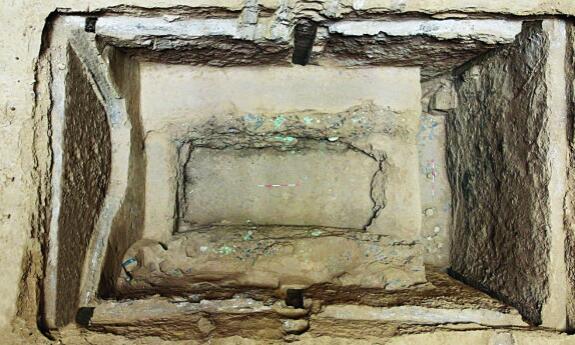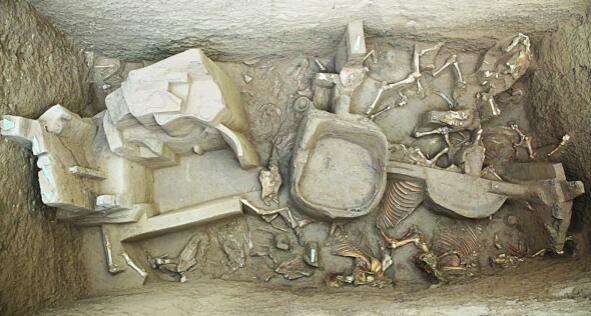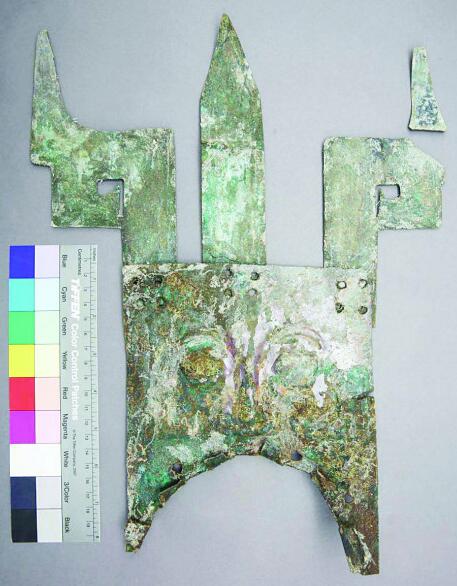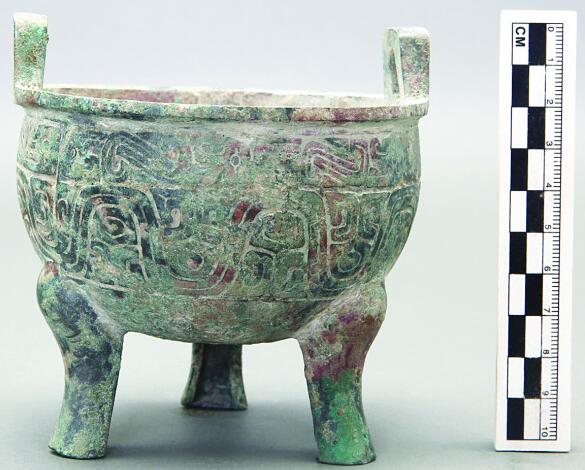New Achievement in Excavation of Shijia Cemetery in Ning County, Gansu Province
In 2018, Gansu Provincial Institute of Archaeology and Cultural Relics continued to implement the archaeological excavation in the east and west sides of the southern part of the Shijia Cemetery, which is located in Ning County, Qingyang City, Gansu Province. Significant achievements were made with 12 tombs of the Eastern Zhou Dynasty and a horse-chariot pit unearthed, and a kiln remains discovered in the cemetery excavated area.

The so-called “Zhe” and square pillars were found right below the “Zhe” at both east and west sides of the outer coffin’s chamber as supporters
Burials: The tombs were basically north-south earthen shaft pit tombs in the rectangle shape. Those who had burial furniture had outer and inner (Double) coffins or the double coffins or single ones. Matting trace was found on the outer coffin of the M6 Tomb, on which there were 21 tiny holes at regular intervals around. It’s likely that those were square wooden rivets wedged to prevent the matting from dropping. Under the cover of the outer coffin, there was a round wooden frame, the so-called “Zhe” recorded in the chapter of JiXiLi (Mourning procedures of the evening preceding burial) of the book of Etiquette and Ceremonial. Square pillars were found right below the “Zhe” at both east and west sides of the outer coffin’s chamber as supporters. New coffin frames were left among the coffin decorations. Under the baseboard of Tomb M166, there was a wooden frame, composed of round logs with a north-south rectangle shaped from inside to outside. The north-south inner frame joined an east-west round log separately at both ends, forming a structure of Chinese characters “口” outside and ”目” inside. Among the identified burial form, only one tomb was of supine extended burial while the rest were all of the flexed burials.

Horse-chariot Pit in MK2
Horse-chariot Pit: A north-south earthen shaft pit was unearthed with two disassembled chariots placed inside both ends of the pit. There were 14 individual horses and a sacrificial dog in the northeast part of the pit.
Kiln remains: A new kiln was discovered in the excavated area, consisting of a fire chamber, kiln door and operating room, totally three parts. The fire chamber of a fan-shape horizontal plane collapsed at the top, with thick burnt soil left on the kiln walls. The operating room, which was located to the south of the fire chamber, was filled with a lot of soil mixed with plant ash, burnt soil pieces and a few animal bones. The exact time remained unknown, but it could be inferred from the stratum of the first layer that it might be earlier than the tombs of Spring and Autumn Period.

A set of funerary jade string ornaments in M6
Burial Objects: The burial objects were mainly bronze sacrificial vessels, chariots and harnesses, funeral wares, personal possessions of the tomb owner, with new progress based on the excavation two years ago.

the “Sha” (A fan used as ceremonial weaponry, like coffin ornament)
And the “Sha” (A fan used as ceremonial weaponry, like coffin ornament) was found out of the tomb for the first time. When the archaeological team was dissecting the inner parts of the second and third carriages in the horse-chariot pit (MK5) in 2018, pairs of bronze “Sha” were discovered overlaying in the southeast, among which there were red painted frames made of wood pieces used as the main part of the bronze Sha backing discovered under the bottom of the lower-layer bronze “Sha” but out of the tomb for the first time. Some personal possession of the tomb owner, a set of funerary jade string ornaments was rather intricate. There were at least five sets of jade string ornaments were found on the cover of the inner coffin of the M6 tomb: ornaments on funerary face covering, necklaces of various jade, necklaces of jade beads and semi-annular pendants, bracelets of various jade, single jade pendants. Besides, proto-porcelains were uncovered for the first time. Two unevenly-glazed porcelain bowls with the inside exposure in the rim and at the bottom were excavated on the cover of the outer coffin in the tomb M6.

Tripod-Ding found in tomb M6
In order to find the settlement of which Shijia Cemetery belonged, the archaeological team also implemented an archaeological investigation in the surroundings. There were a great many ash pits of the Zhou Dynasties uncovered in the Yucun Site in the east. The collected pottery Li Pots with folded shoulders had an obvious characteristic of Spring and Autumn Periodic style. Meanwhile, Nanjing University implemented a salvage excavation at Yucun Site, for the very first time as a historical and cultural site protected at the provincial level, which was of great significance. Tombs (of east-west found for the first time), house foundations, ash pits, ash ditches, kilns and many more were found with complex relationship of overlapping and broken each other. The plentiful relics unearthed could be divided by material into the bone, pottery, seashell, jade, stone and so on. The most impressive was the discovery of numerous pottery pieces and groovy pan tiles of Spring and Autumn Period, which played an essential and indicative role for the judgment of residential area of the people in Shijia Cemetery. (Translator: Yuan Yuan)

